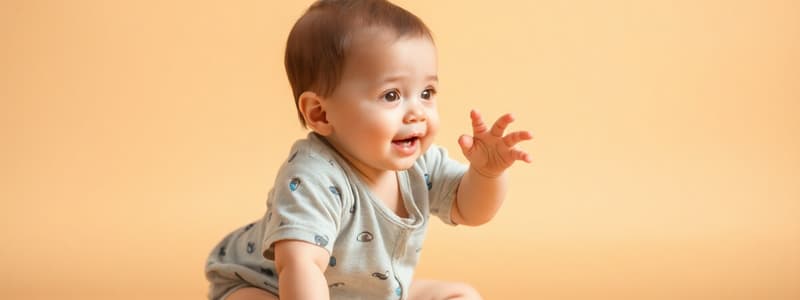Podcast
Questions and Answers
Which of the following best describes the concept of neonatal imitation?
Which of the following best describes the concept of neonatal imitation?
- Infants consciously mimicking actions they see others perform after careful consideration.
- Infants learning to perform complex motor tasks through repeated practice and reinforcement.
- Infants associating specific sounds with particular visual stimuli.
- Infants automatically equating their own unseen behaviors with gestures they see others perform. (correct)
Classical conditioning is primarily based on learning through imitation of others' actions.
Classical conditioning is primarily based on learning through imitation of others' actions.
False (B)
Briefly explain how habituation is used as a methodology to study learning in infants.
Briefly explain how habituation is used as a methodology to study learning in infants.
Habituation involves presenting a stimulus repeatedly until the infant's response decreases. This decline indicates that the infant has learned to recognize the stimulus and is no longer novel. Researchers measure the rate of habituation and subsequent recovery to novel stimuli to assess learning abilities.
__________ preference refers to the tendency of infants to pay more attention to new stimuli compared to familiar ones.
__________ preference refers to the tendency of infants to pay more attention to new stimuli compared to familiar ones.
Match the following learning mechanisms with their descriptions:
Match the following learning mechanisms with their descriptions:
According to the dynamic systems approach to motor skill development, which of the following is NOT considered a primary factor influencing the acquisition of a new motor skill?
According to the dynamic systems approach to motor skill development, which of the following is NOT considered a primary factor influencing the acquisition of a new motor skill?
The 'Sticky Mittens' experiment with 3-month-olds demonstrated that early motor skill training at home has no impact on prehension abilities in a lab setting.
The 'Sticky Mittens' experiment with 3-month-olds demonstrated that early motor skill training at home has no impact on prehension abilities in a lab setting.
In the context of infant motor development, what is meant by 'Specificity of Learning' as highlighted by Adolph (2000)?
In the context of infant motor development, what is meant by 'Specificity of Learning' as highlighted by Adolph (2000)?
According to the dynamic systems theory, the development of motor skills is influenced by the interaction of the central nervous system, the body's movement capabilities, the child's __________, and environmental supports.
According to the dynamic systems theory, the development of motor skills is influenced by the interaction of the central nervous system, the body's movement capabilities, the child's __________, and environmental supports.
Karasik et al.'s (2015) cross-cultural study on sitting in 5-month-olds primarily investigated:
Karasik et al.'s (2015) cross-cultural study on sitting in 5-month-olds primarily investigated:
Infants demonstrating advanced reaching skills with their hands will automatically exhibit the same proficiency when reaching with their legs.
Infants demonstrating advanced reaching skills with their hands will automatically exhibit the same proficiency when reaching with their legs.
Adolph's (2000) research on 'Specificity of Learning' suggests that if an infant learns to avoid falling from a sitting position, they will:
Adolph's (2000) research on 'Specificity of Learning' suggests that if an infant learns to avoid falling from a sitting position, they will:
List two factors that play a role in an infant's ability to reach a motor milestone.
List two factors that play a role in an infant's ability to reach a motor milestone.
In classical conditioning, what type of association is formed?
In classical conditioning, what type of association is formed?
Operant conditioning involves the decrease of behavior when rewarded.
Operant conditioning involves the decrease of behavior when rewarded.
What is the High Amplitude Sucking (HAS) procedure used for in studies with newborns?
What is the High Amplitude Sucking (HAS) procedure used for in studies with newborns?
__________ is the gradual reduction in the strength of a response due to repetitive stimulation.
__________ is the gradual reduction in the strength of a response due to repetitive stimulation.
What occurs when a new stimulus is presented after habituation has taken place?
What occurs when a new stimulus is presented after habituation has taken place?
Newborns prefer pure tones over complex sounds like voices.
Newborns prefer pure tones over complex sounds like voices.
What aspects of language do newborns recognize and prefer due to prenatal exposure?
What aspects of language do newborns recognize and prefer due to prenatal exposure?
__________ perception refers to the integration of stimulation from different sensory modalities.
__________ perception refers to the integration of stimulation from different sensory modalities.
Match the age with the corresponding speech perception development.
Match the age with the corresponding speech perception development.
What is the 'Perceptual Narrowing Effect'?
What is the 'Perceptual Narrowing Effect'?
Perceptual narrowing is independent of experience.
Perceptual narrowing is independent of experience.
Around what age do infants start to prefer faces of their own race, and what factor primarily affects this preference?
Around what age do infants start to prefer faces of their own race, and what factor primarily affects this preference?
Newborns prefer faces with open eyes and __________ gaze.
Newborns prefer faces with open eyes and __________ gaze.
At what age do infants typically begin to discriminate emotional expressions?
At what age do infants typically begin to discriminate emotional expressions?
Motor development milestones occur in a strict, unchangeable sequence for all infants.
Motor development milestones occur in a strict, unchangeable sequence for all infants.
Flashcards
Imitation
Imitation
Learning through watching and copying others' actions.
Association in learning
Association in learning
Learning by connecting two things together through repeated pairings
Classical Conditioning
Classical Conditioning
Learning through linking a neutral stimulus with a meaningful one.
Operant Conditioning
Operant Conditioning
Signup and view all the flashcards
Novelty Preference
Novelty Preference
Signup and view all the flashcards
Factors in Motor Skill Development
Factors in Motor Skill Development
Signup and view all the flashcards
'Sticky Mittens' Experiment
'Sticky Mittens' Experiment
Signup and view all the flashcards
Limb-Specific Exploration
Limb-Specific Exploration
Signup and view all the flashcards
Cultural Variation in Sitting
Cultural Variation in Sitting
Signup and view all the flashcards
Environmental Influences on Sitting
Environmental Influences on Sitting
Signup and view all the flashcards
Specificity of Learning
Specificity of Learning
Signup and view all the flashcards
Infant Learning: Motor Milestones
Infant Learning: Motor Milestones
Signup and view all the flashcards
Sitting and Crawling Relation
Sitting and Crawling Relation
Signup and view all the flashcards
Associative Learning
Associative Learning
Signup and view all the flashcards
High Amplitude Sucking (HAS)
High Amplitude Sucking (HAS)
Signup and view all the flashcards
Habituation
Habituation
Signup and view all the flashcards
Dishabituation
Dishabituation
Signup and view all the flashcards
Intermodal Perception
Intermodal Perception
Signup and view all the flashcards
Infant-directed Speech
Infant-directed Speech
Signup and view all the flashcards
Perceptual Narrowing Effect
Perceptual Narrowing Effect
Signup and view all the flashcards
Phoneme Discrimination
Phoneme Discrimination
Signup and view all the flashcards
Visual Acuity
Visual Acuity
Signup and view all the flashcards
Preference for Conspecifics
Preference for Conspecifics
Signup and view all the flashcards
Depth Perception
Depth Perception
Signup and view all the flashcards
Visual Cliff
Visual Cliff
Signup and view all the flashcards
Gross-Motor Development
Gross-Motor Development
Signup and view all the flashcards
Study Notes
- Focus: Learning, Motor and Perceptual Development in Infancy.
Learning in Infancy
- Infants learn through imitation, association, and novelty preference.
- Classical and Operant conditioning are types of association that are also used as methodologies to study learning.
- Habituation is used as a method to study learning.
Neonatal Imitation
- Newborns can implicitly equate their unseen behaviors with observed gestures, such as sticking out their tongue.
- Imitation can be a way for infants to explore the world.
- Imitation can be linked to an increase in mouth and tongue movements in response to any interesting stimulus.
- Neonatal imitation may disappear between 2 to 3 months of age, and be replaced by more deliberative imitation at approximately 6 months.
- Macaque newborns imitate humans.
Associative Learning
- Associations between neutral and natural stimuli occur through classical conditioning.
- Operant conditioning is when a behavior increases when rewarded.
- Newborns suck faster when this action produces rewards, which is also known as the High Amplitude Sucking- HAS procedure.
- Infants also kick more when this action produces rewards.
- Operant conditioning is used in studies on infant language and memory.
Response to Novelty
- Habituation is a gradual reduction in the strength of a response due to repetitive stimulation.
- Recovery is shown when a new stimulus is presented.
- By 30 weeks gestation, fetuses habituate to sounds and show heart rate decelerations.
- Infants dishabituate to music after listening to speech, and vice versa.
- After a 10-minute delay, babies habituate more quickly.
Speech Perception
- Infants prefer mom's voice over other voices, full term fetuses and newborns show this preference.
- Newborns preferences change the more they are exposed to a filtered voice that sounds like it did in utero.
- Infants recognize, and prefer language and stories heard in utero (last 6 weeks).
- Infants prefer "infantese."
- Adults help infants to develop temporal synchrony.
- From birth to about six months, infants are universal language learners.
- From 6-12 months, babies become experts in their native language, and recognize familiar words in speech.
- They prefer listening to words they have previously heard in speech, and passages that contain words they heard in isolation.
Perceptual Narrowing Effect
- There is a perceptual sensitivity that increases with age and experience.
- Domains from 6-12 months include phonemes and faces of own species compared to other species.
Perceptual Narrowing: Experience
- There is a preference for processing faces of different races.
- Newborns do not have a preference, but 3-month-olds prefer own race faces over other race faces.
- The ability to discriminate faces of one's own race is higher than other races.
- At 9-months-olds performance declines and is worse than younger babies, but this is dependent on experience.
- Regular exposure to Mandarin Chinese allows 10-month-olds retain phoneme discrimination abilities and is similar to results for other race faces.
Elements of Vision
- Focus: acuity or fineness of discrimination, includes near and far objects.
- Color
- Motion
- Scanning and tracking.
- Depth, patterns, objects, and faces are additional elements of vision.
- Distant objects' visual acuity improves from 20/600 in newborns, to 20/80 at 6 months, and reaches 20/20 at the age of 4 years.
- Focusing abilities becomes adult-like at approximately 2 months of age.
- Color discrimination appears at 4 months.
Face Perception
- Newborns prefer upright faces, or faces that orient towards conspecifics, versus upside down or sideways faces, and prefer top-heavy patterns.
- They prefer faces with open eyes and direct gaze, and 'attractive' faces.
- At 1 month infants recognize their mom.
- At 2-3 months infants explore internal features.
- At 3 months infants discriminate between strange faces and prefer female faces to male faces.
- They recognize own race faces, and this preference changes depending on experience.
- At 5 months infants discriminate emotional expressions such as postivie and negative ones.
Depth Perception
- Depth perception is the ability to judge distance of objects from one another and from ourselves.
- Newborns are sensitive to motion.
- At 2 to 3 months, binocular depth cues emerge.
- By 3 months, infants perceive objects as three-dimensional.
- After 3 months, pictorial depth cues are used.
- Motor development plays a role.
- Independent movement and the visual clift contribute to depth perception.
- Crawling experience helps with depth.
- Each new motor development is a recalibration of depth cues.
Motor Development
- Gross-motor development includes crawling, standing, and walking.
- Fine-motor development involves reaching, grasping, and pincer grasp.
- Individual differences in rate and order of skill acquisition are normal.
- 'Normal' is a wide range.
- Motor skill development is a dynamic system that consists of Central Nervous System (brain) development, body's movement capacity- muscular, skeletal growth, child's goals, environmental supports and differences across cultural contexts.
- Motor development is looked at through Sticky Mittens studies and reaching studies.
Sway model for postural milestones
- Experiences with an earlier-developing skill does not transfer automatically to a later-developing skill.
- Sitting, crawling, and walking postures involve regional permissible sway for different key pivots.
- Extensive experience with each postural milestone in development may be required to master that system.
- Different muscle groups, vantage points and correlations between visual, kinesthetic, and vestibular information all factor into development.
Studying That Suits You
Use AI to generate personalized quizzes and flashcards to suit your learning preferences.




